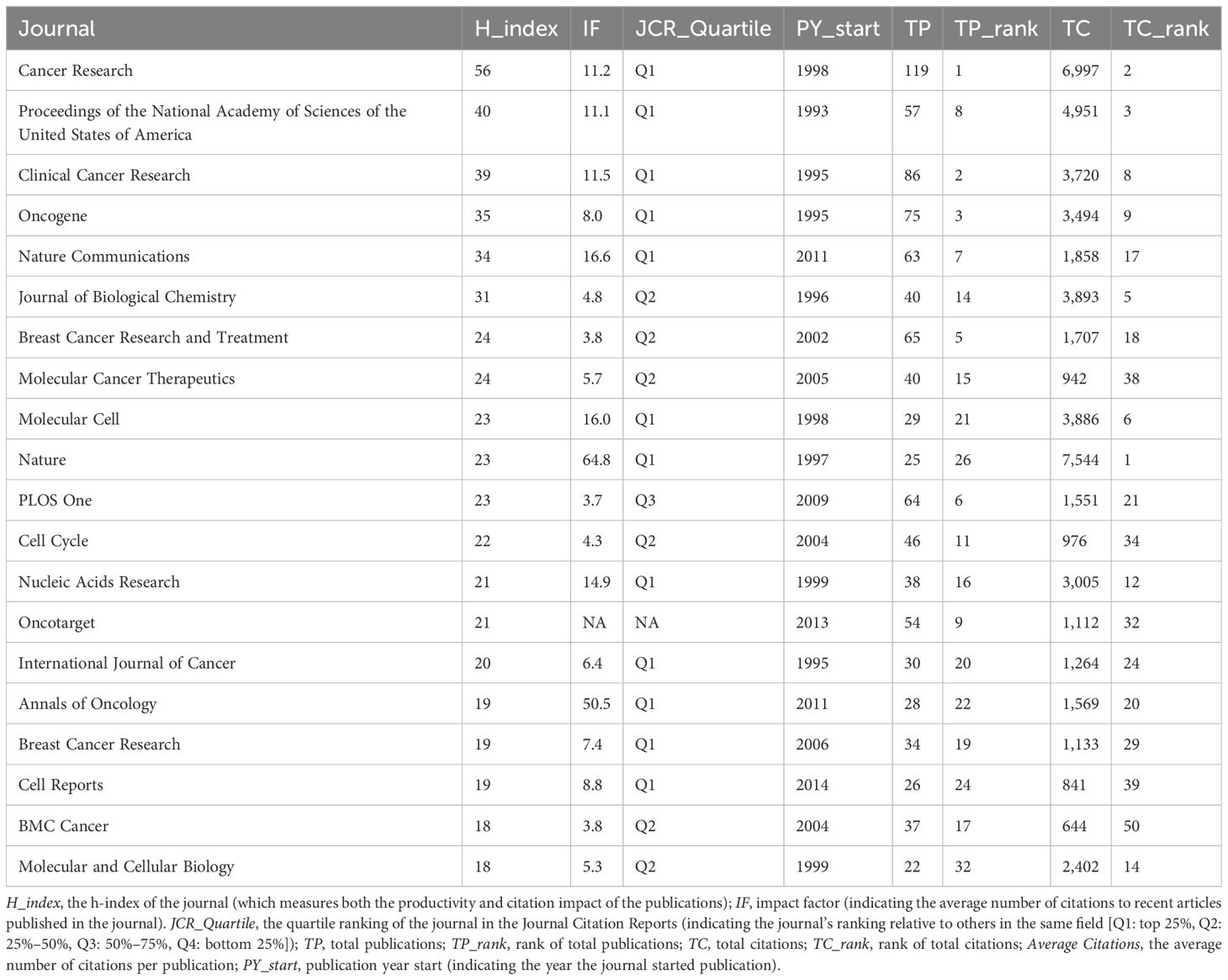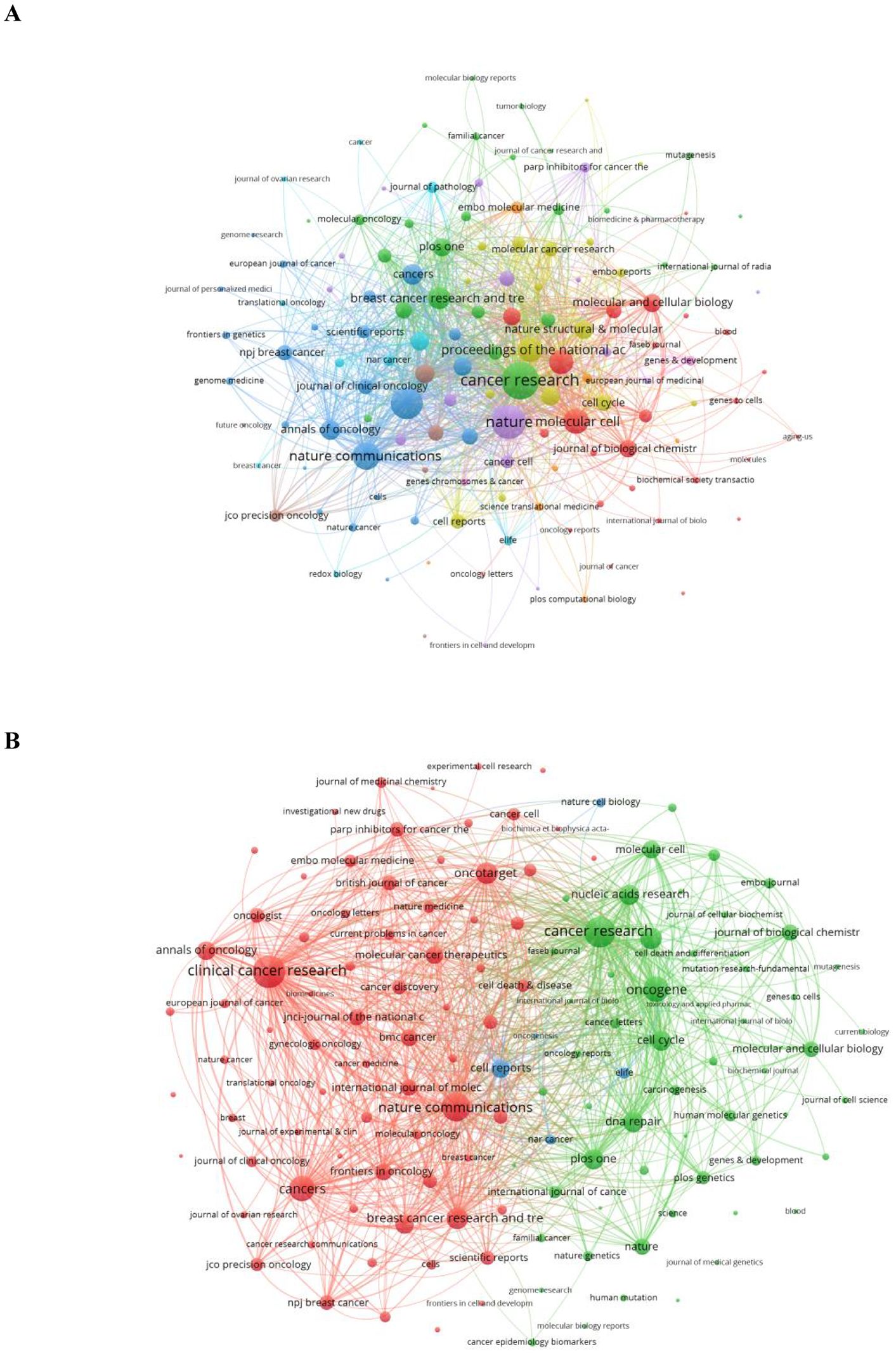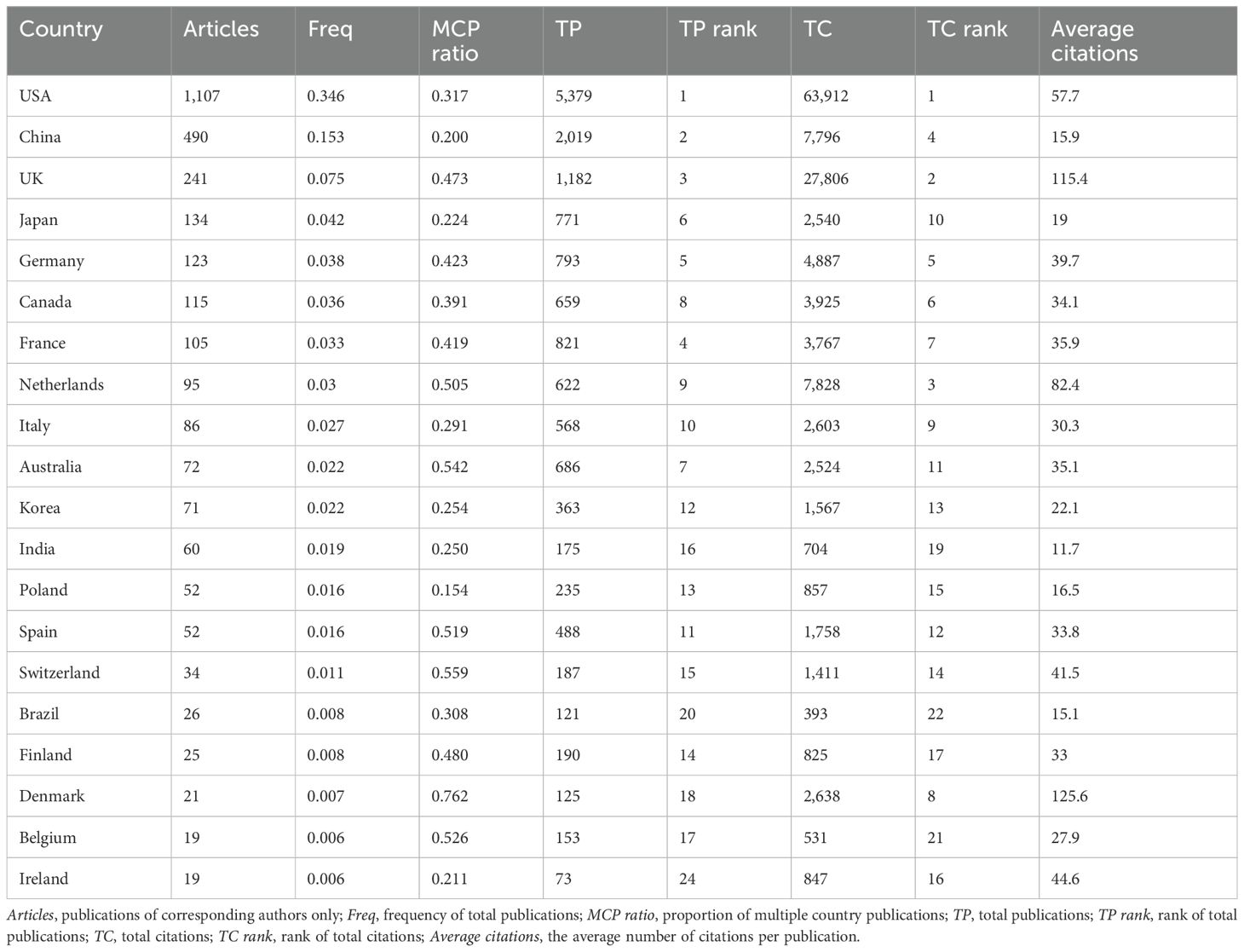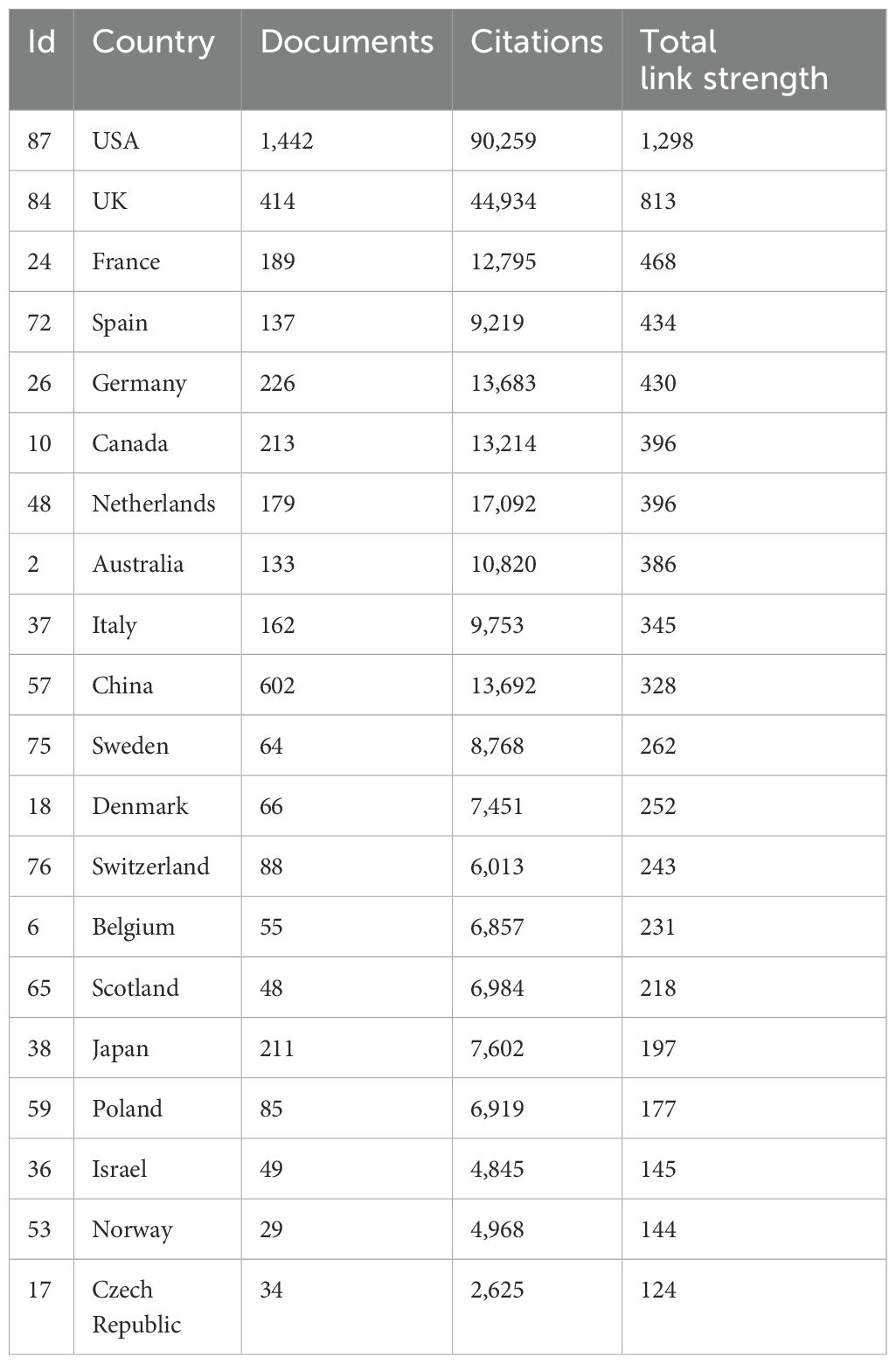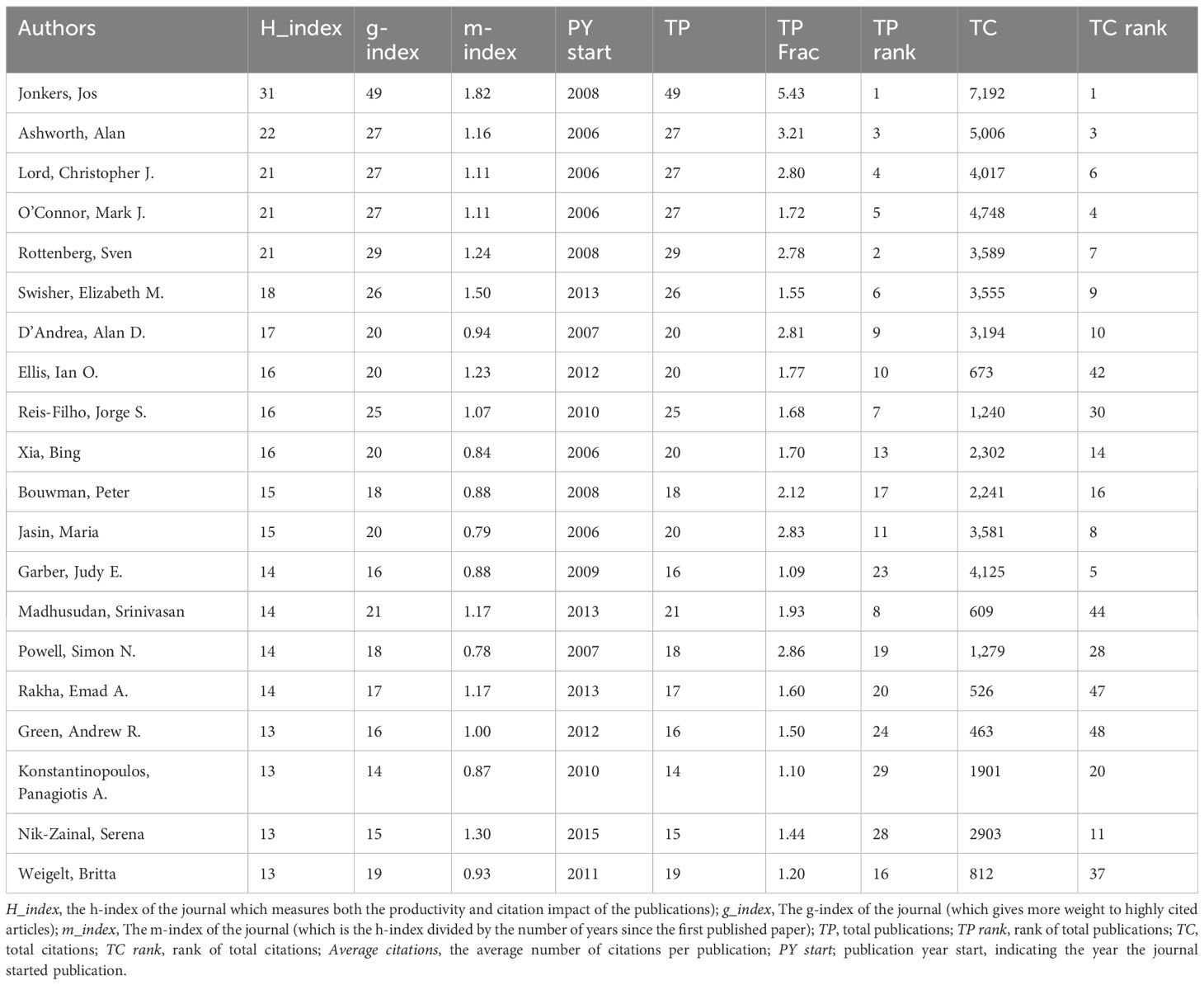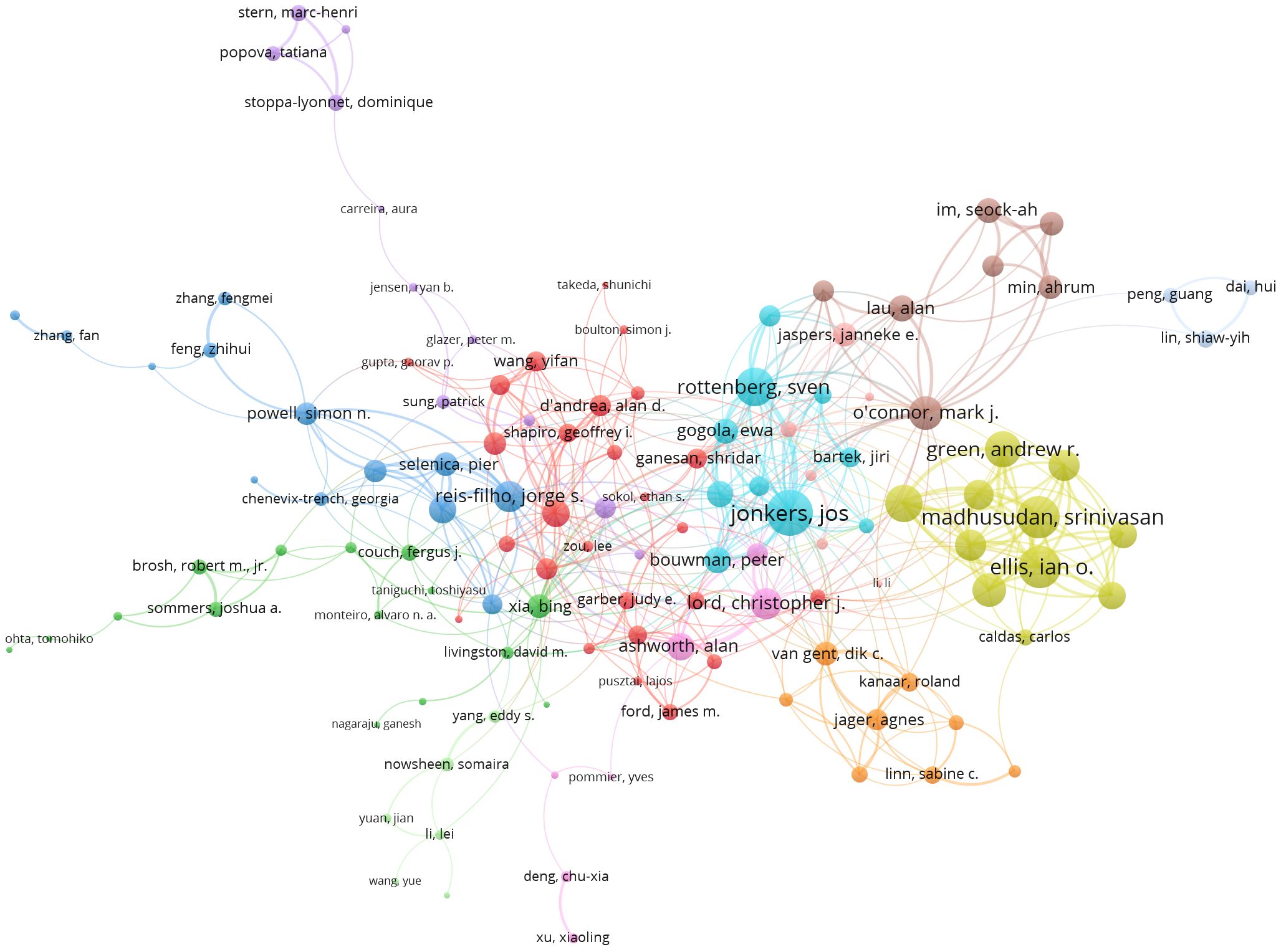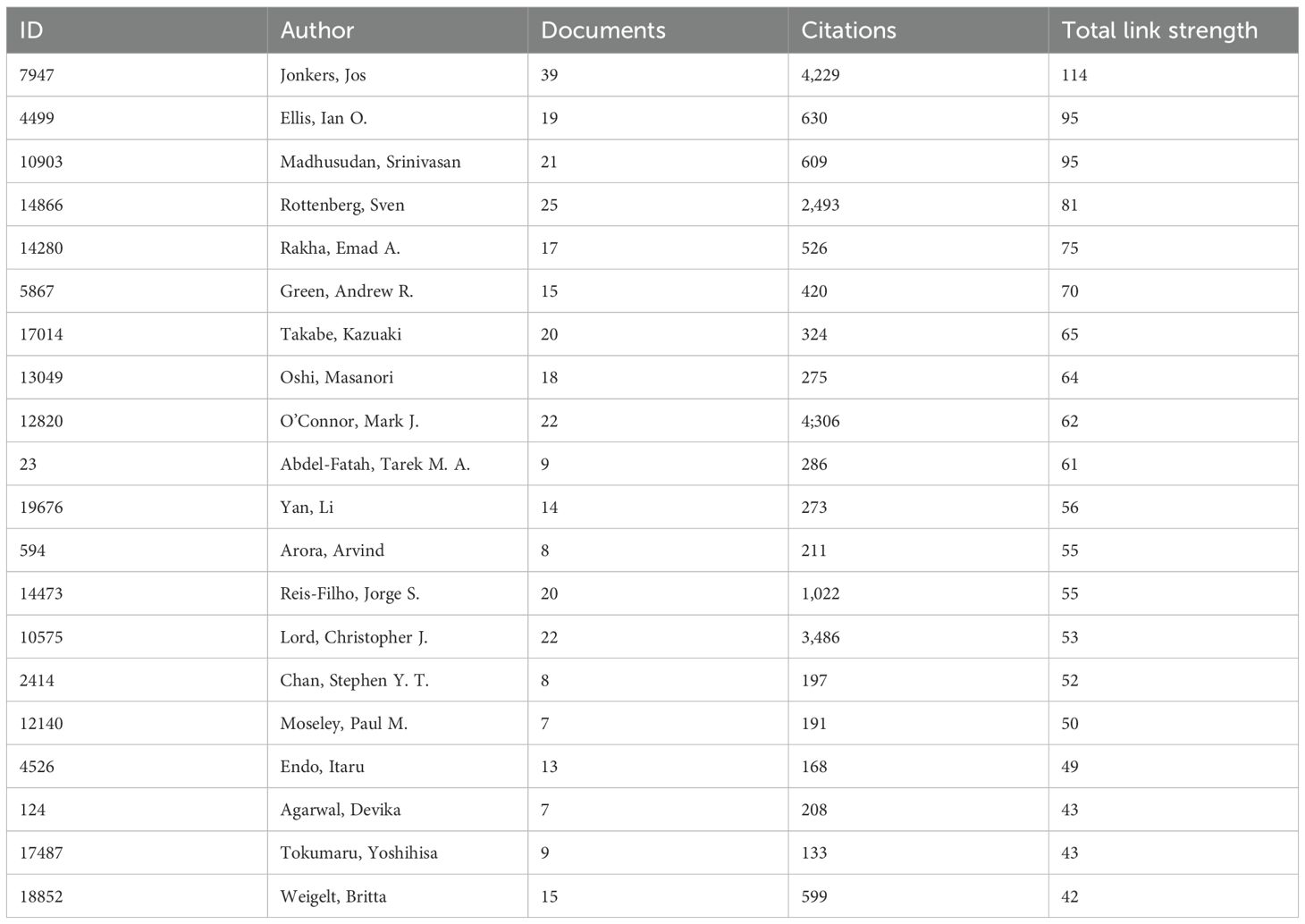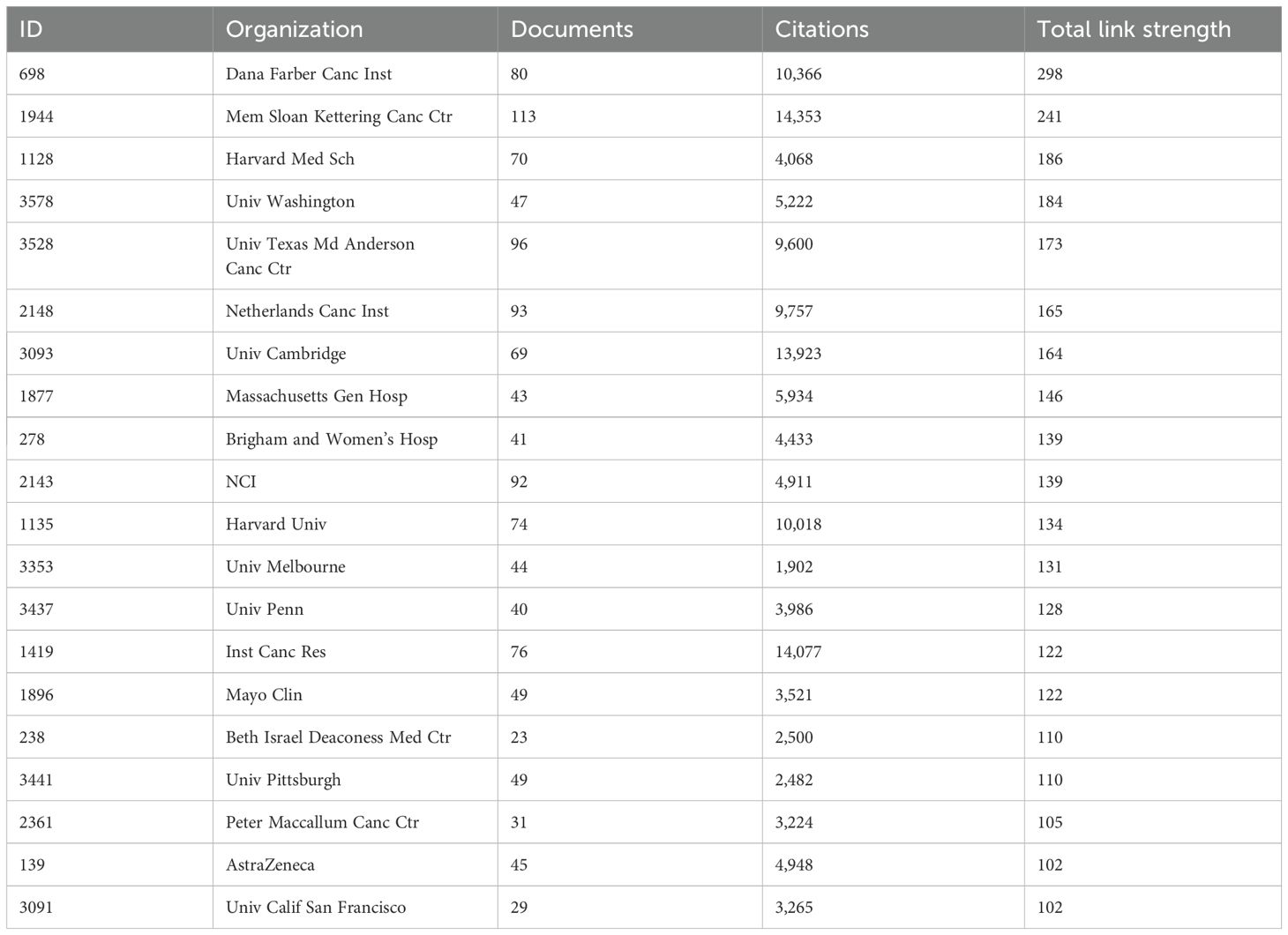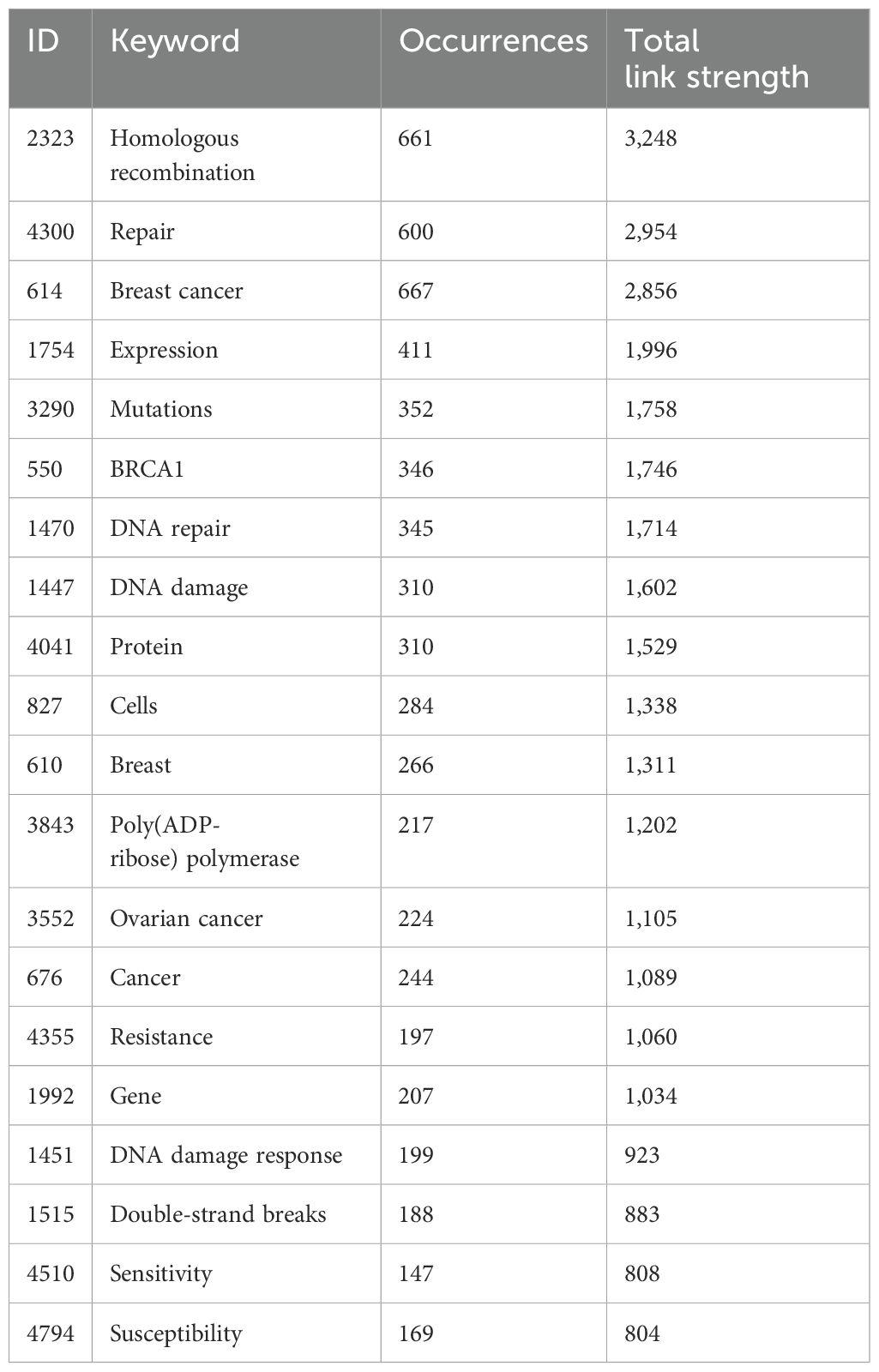- 1Department of Pathology, the Second Affiliated Hospital, Zhejiang University, School of Medicine, Hangzhou, China
- 2Department of Breast Surgery and Oncology, the Second Affiliated Hospital, Zhejiang University, School of Medicine, Hangzhou, China
Background: Breast cancer remains one of the leading causes of cancer-related morbidity and mortality among women worldwide. Recent advancements in our understanding of DNA damage repair (DDR) mechanisms have shed light on their specific role in the pathogenesis, progression, treatment resistance, and prognosis of breast cancer. In this study, we conducted a bibliometric study to map the global trends in DDR-related breast cancer research.
Methodology: A search of publications on DDR in breast cancer from 1990 to 2024 was conducted using the Web of Science Core Collection. A comprehensive bibliometric analysis of the data was performed using CiteSpace, VOSviewer, and Bibliometrix. Additionally, for clinical trial data, the databases ClinicalTrials.gov (https://www.clinicaltrials.gov) and the WHO International Clinical Trials Registry Platform (ICTRP) (https://trialsearch.who.int) were queried.
Results: The results revealed a continuous and steady growth in the number of articles published in this area over the past three decades and showed that the USA had produced the highest number of publications in this field, while Harvard University had published the largest number of articles. Jonkers, Jos was found to be the most published author, with 39 documents. Analysis of the journals showed that Cancer Research ranked as the most published journal, while Nature was the most cited. Combined with the keyword co-occurrence analysis and co-citation analysis, it emerged that “Targeting the DNA repair defect as a therapeutic strategy”, published in Nature (IF = 64.8) in 2005, had accumulated 529 local citations, indicating that research topics have focused on treatment regimens. For clinical trials, 124 studies were initially sourced—108 from ClinicalTrials.gov and 16 from ICTRP. After repetitive and correlation-based screening, 43 trials specifically addressing 13 different DDR-related drugs in breast cancer were included.
Conclusion: Overall, this study provides valuable insights into the current research achievements, latest advancements, and emerging global trends in DNA damage repair-related breast cancer research. With sustained clinical focus, more high-quality investigations combining DDR inhibitors with other treatment modalities are needed.
1 Introduction
Breast cancer is known to be the most common cancer and the leading cause of cancer-related deaths among women worldwide. The tumor is characterized by different molecular subtypes and heterogeneous biology, with a complex genomic landscape, and is also linked to impaired DNA damage repair (DDR) mechanisms (1–6), thus leading to varied therapeutic responses. DDR functions as a complex and coordinated mechanism that enables tissues and cells to cope with endogenous and exogenous DNA damage, thereby preventing genomic instability (7). Moreover, DDR pathways are essential for maintaining genomic stability, and their dysfunction can lead to tumorigenesis. The exploration of these pathways in the context of breast cancer research has gained momentum, as understanding these mechanisms can lead to the development of targeted therapies that exploit vulnerabilities in cancer research (3, 5).
When we look at DDR pathways and their association with breast cancer, we know that, as a malignant tumor, breast cancer harbors more DNA damage and replication stress, and the continual accumulation of DNA damages induces apoptosis and cell death. Different forms of DNA damage evoke different repair mechanisms and signaling pathways. There are six major repair pathways: nucleotide excision repair (NER) pathway, which deals with modified nucleotides; the base excision repair (BER) pathway, responsible for DNA single‐strand breaks; the mismatch repair (MMR) pathway, which addresses replication errors; the homologous recombination repair (HRR) pathway; the Fanconi anemia (FA) pathway, which repairs DNA interstrand crosslinks; the and nonhomologous end‐joining (NHEJ) pathway, which deals with DNA double‐strand breaks. Cell‐cycle checkpoints are also important for DDR to prevent DNA damage (7, 8). Previous studies have demonstrated that DDR alterations are common and crucial in various cancers. Germline mutations in DDR genes may predispose individuals to breast, ovarian, prostate, and pancreatic cancers (9–11). Mutations in Breast Cancer1/2 (BRCA1/2) are known to be important mechanisms responsible for HRR and are strongly associated with breast cancer risk. Breast BRCA1/2 also acts as predictive biomarkers for DNA-targeting therapies, such as poly(ADP‐ribosome) polymerase (PARP) inhibitors (12). In addition to germline BRCA1/2 mutations, other genes of vital importance that are associated with breast cancer, such as Ataxia Telangiectasia Mutated (ATM), Partner and Localizer of BRCA2 (PALB2), and Checkpoint Kinase 2 (CHEK2), also belong to the DDR pathway and are involved in the response to DDR‐targeting therapies (13). The complete DDR mutation status and other DDR gene mutations have not been well explored, especially in the somatic context. For anticancer therapies, downregulated expression of HRR proteins induces homologous recombination deficiency and increases the sensitivity to PARP inhibitors (14). However, when it comes to some other genes associated with different DDR pathways, it has been noted that loss of expression of MMR and NHEJ proteins, together with overexpression of NER pathway proteins, causes PARP inhibitor resistance (15–17). It has also been reported that DDR mutations are associated with an increased tumor mutation burden (TMB) in solid tumors (18). As far as we are concerned, intensive study is needed to manipulate the optimal expression of these DDR proteins. In the area of immunotherapy, DDR mechanisms and the role they play have been studied (19–21). Since breast cancer has been deemed an immunologically cold lesion, determining how to select potentially eligible patients and conduct therapeutic measures, including immunotherapy, is of great importance and requires further exploration (22). In summary, it is necessary to profoundly understand DDR alterations in breast cancer.
In terms of DDR’s specific clinical significance in breast cancer treatment, recent studies have shown that the benefit of PARP inhibitors extends beyond patients with germline BRCA1/2-associated metastatic breast cancer to those with somatic BRCA1/2 variants and to those with germline PALB2 alterations (23). In the phase III OlympiAD trial, olaparib improved progression-free survival (PFS) (hazard ratio [HR], 0.58 [95% CI, 0.43–0.80]; p <.001), doubled the objective response rate (ORR) (59.9% vs. 28.8%), and had a more favorable safety profile compared with physician’s choice treatment in patients with gBRCA1/2 variants who were pretreated with up to two lines of chemotherapy for metastatic breast cancer (24).
The bibliometric analysis serves as a valuable method used to shed light on the developmental status and research frontiers in specific areas and vast scenarios (25). It is recognized as an interdisciplinary science based on statistical and visualization techniques. A bibliometric analysis of research on multiple criteria decision-making depicted its developmental status and revealed its research focus in different periods (26, 27). In the biomedical area, bibliometric studies have also been widely conducted (28). Conducting a bibliometric study can provide a deep understanding of the landscape of DNA damage repair-related breast cancer, thereby inspiring interdisciplinary collaborations and identifying gaps in knowledge and potential areas for further investigation. In this study, we take a quantitative approach to analyze publication trends, influential works, and the evolution of research themes by employing bibliometric analysis to review literature related to DDR and breast cancer. This approach allows us to summarize complex information, highlight collaboration patterns, and identify emerging research frontiers.
2 Methodology
2.1 Search strategies and data collection
A comprehensive search was conducted on the Web of Science Core Collection (WoSCC). The search strategy included central terms such as “breast cancer” and “DNA damage repair” followed by detailed topic words: “breast cancer” or “breast neoplasm” or “breast carcinoma” or “mammary cancer” or “mammary neoplasm” or “mammary carcinoma” and “DNA damage repair” or “DDR” or “DNA repair deficiency” or “homologous recombination repair” or “HRR” or “homologous recombination deficiency” or “HRD”, covering publications from 1990 to 2024, which encompass key developments in the field. The publication language for this study was set to English. Among various types of documents, only articles were considered. To avoid discrepancies from database updates, the literature retrieval was performed on a single day (22 May 2024). All data were collected in the text format. The collected information included the number of publications and citations, titles, author details, institutions, countries/regions, keywords, and journals, all of which were used for further bibliometric analysis. A total of 3,204 eligible publications were included in the present study. The flowchart for data screening is shown in Figure 1.
2.2 Bibliometric analysis
We exported relevant data from the retrieved literature titles and used Microsoft Excel to identify and calculate bibliometric indicators. These indicators encompassed key aspects of the publications, including annual publication quantity, citation frequency, average citation frequency, journal name, journal impact factor, publishing country/region, publishing institution, and corresponding author. By leveraging Excel, researchers were able to efficiently organize and analyze the bibliometric data. During the visualization analysis process, we utilized three powerful bibliometric tools to conduct a comprehensive analysis of the academic data. These tools were VOSviewer (version 1.6.20), CiteSpace (version 6.3. R1), and an online bibliometric tool (https://bibliometric.com/). VOSviewer is a multifunctional software tool that plays a key role in mapping institutional collaborations, author collaborations, co-authorship, citation, and co-citation (doi: 10.1007/s 11192-009-0146-3) (29). Using VOSviewer, we were able to visualize and explore complex networks of collaboration and relationships within the academic field, gaining deeper insights into the interconnections between authors, institutions, and publications. To gain a deeper understanding of emerging trends and research hotspots in our field, we used VOSviewer for keyword co-occurrence analysis and CiteSpace for keyword burst detection (30).
Using CiteSpace 6.1.R3, we conducted a keyword co-occurrence analysis with time slicing as the parameter, covering the period from January 1996 to May 2024 (the first research in this field was published in 1996). The time slice was set to 1 year. The node type was set to keywords, with the threshold for each segment being the top 5 names. Pruning was set to pathfinder and pruning merged the network. Based on the parameter settings, a visual analysis was performed to generate a keyword timeline in the research field of “DNA repair defects in breast cancer”.
The collected data were analyzed using the bibliometric software of VOSviewer and Bibliometrix to generate visual maps illustrating publication trends, thematic clustering, and citation networks. The size of the nodes represents the number of publications, the thickness of the lines indicates the strength of the link, and the color of the nodes corresponds to different clusters or time periods. Key metrics, such as the number of publications, citations, and the H-index of authors and institutions, were considered to assess research impact and predict future achievements. In our study, the H-index of individuals and journals was obtained from WoSCC.
2.3 Clinical trial analysis
Data were extracted from ClinicalTrials.gov and the World Health Organization’s International Clinical Trials Registry Platform (ICTRP). A search was conducted using the parameters “DDR OR DNA damage repair” and “breast cancer” on 11 November 2024. Initially, 108 trials from ClinicalTrials.gov and 16 from ICTRP were retrieved. The author then performed a repetitive and correlation-based screening, excluding trials not related to breast cancer or DDR-related drugs. Afterward, data from the two databases were amalgamated, and duplicate trials were removed. Finally, 43 trials investigating DDR-related drugs for breast cancer were included in our analysis. Information on relevant variables, such as study design, status, phase, conditions, interventions, outcomes, and commencement dates, was reviewed.
3 Results
3.1 The overall situation of the research field
Our study examined 3,204 publications, all of which are articles. The analysis showed that 23,696 authors from 14,417 institutions across 601 countries/regions contributed to the production of these manuscripts. These works were published in 698 journals and cited 79,240 references (Figure 2A).
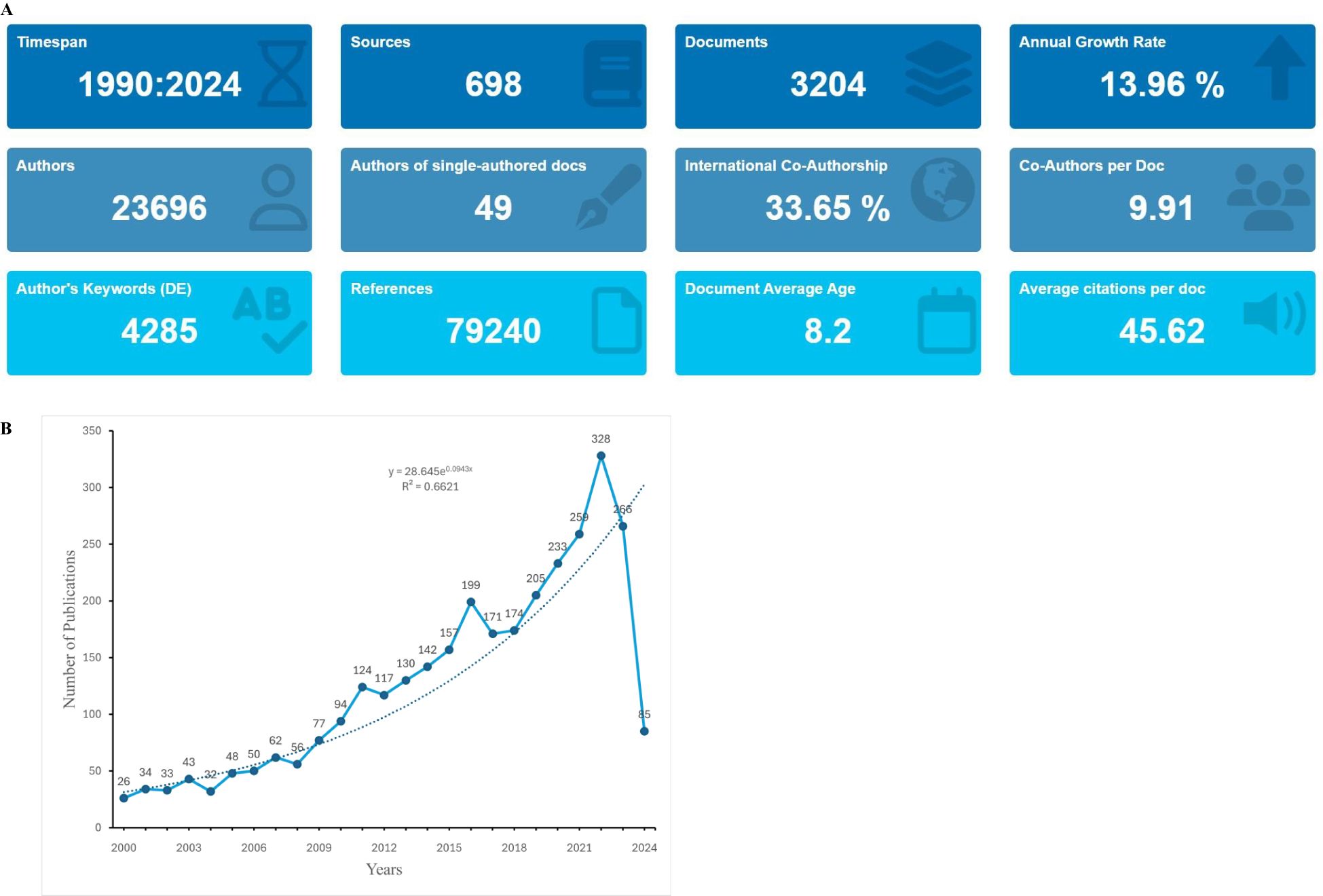
Figure 2. (A) Overview of publications on DNA repair deficiency in breast cancer. (B) Annual number of publications.
3.2 Publication trends
The analysis revealed a steady increase in the number of publications focusing on DNA damage repair in breast cancer over the study period from January 1996 to May 2024. Publications from 2000 to 2024 were analyzed based on the search strategy. Figure 2B illustrates the overall trend in the number of publications from 2000 to 2024, with a notable spike in research output after 2014. This trend aligns with the growing focus on personalized medicine and targeted therapy in oncology.
The high-impact journals in this research field are listed in Table 1. Among the publications, the most cited article was titled “Targeting the DNA repair defect in BRCA mutant cells as a therapeutic strategy” and was published in Nature (impact factor (IF) = 64.8) in 2005, which accumulated a total of 4,753 citations (doi: 10.1038/nature03445). The article with the highest IF (158.5) was titled “Niraparib maintenance therapy in platinum-sensitive, recurrent ovarian cancer”, published in the New England Journal of Medicine (IF = 158.5) in 2016, which accumulated a total of 1,670 citations (doi: 10.1056/NEJMoa1611310). We also analyzed the distribution and co-occurrence of journals containing this topic. The co-occurrence networks of journals include 135 journals with at least five occurrences. The three key journals with the highest total link strength in co-occurrence networks were Cancer Research (1,349), Nature (1,137), and Clinical Cancer Research (989) (Figure 3A). Furthermore, the coupling networks of journals also consist of 135 journals with at least five couplings. The three key journals with the highest total link strength in the co-occurrence networks were Clinical Cancer Research (90,966), Cancer Research (82,308), and Nature Communications (71,474) (Figure 3B).
3.3 Analysis of the countries
In total, articles published in this field were contributed by 50 countries/regions. The top 10 most productive countries generated 2,568 articles, accounting for 80% of all papers worldwide. The USA was the most productive country, with the highest number of articles (n = 1,107), followed by China (n = 490) and the UK (n = 241). Among the top 10 productive countries/regions, as shown in Figure 4A; Table 2, the USA held the leading position in terms of average citations (n = 57.7), reflecting the significant impact and widespread interest generated by its research contributions. Among the 38 countries involved in international collaborations with at least one article, the USA had the highest number of collaborations (1,298), followed by the UK (813) and France (468) (Table 3). The data were analyzed using VOSviewer (Figure 4).
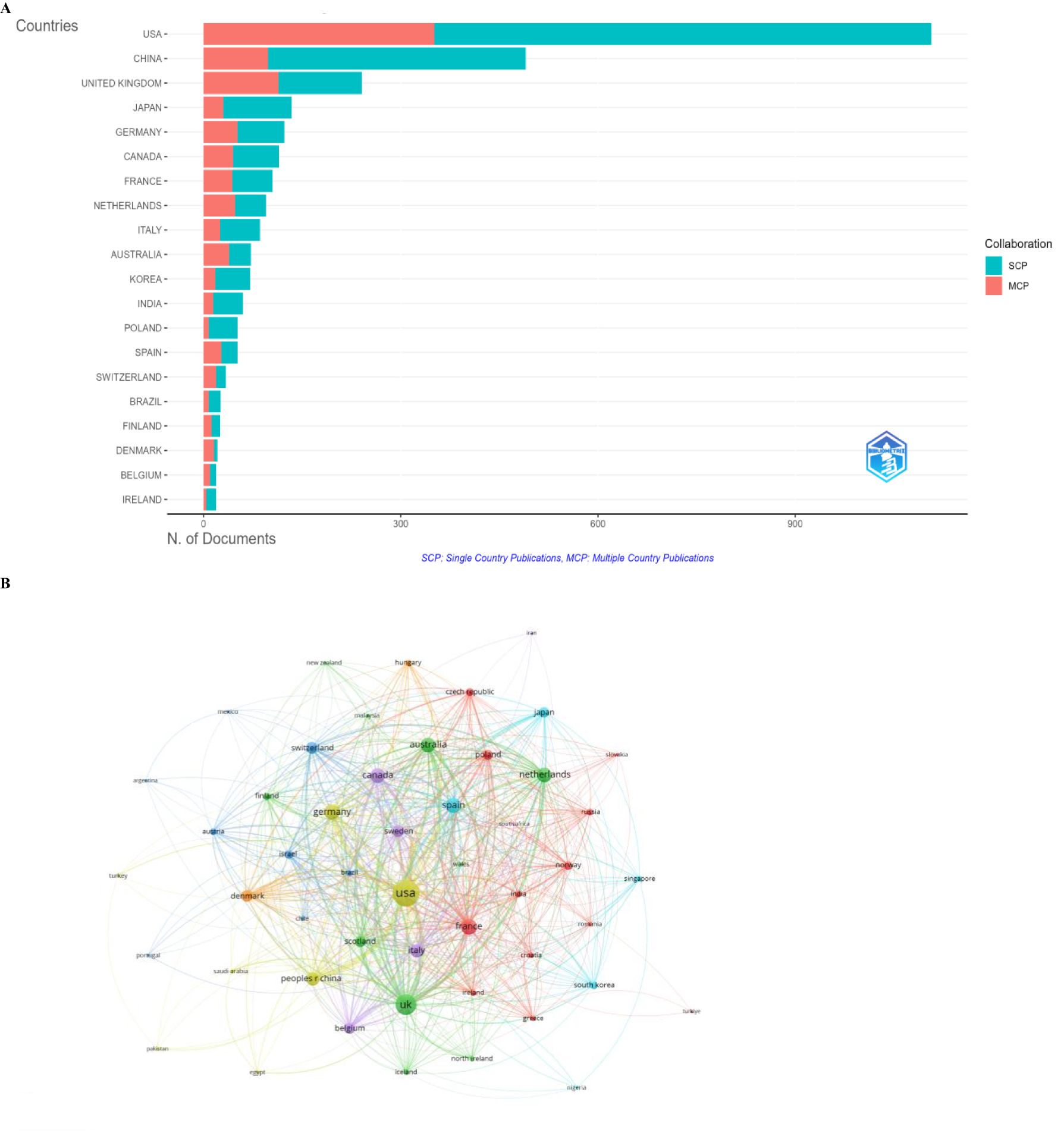
Figure 4. (A) Distribution of corresponding author’s publications by country (R Bibliometrix). (B) Visualization map showing collaboration among different countries.
3.4 Authors’ impact and co-occurrence network
As shown in Table 4, among the authors with high publication and citation impact, Jonkers, Jos ranked first, with the highest h-index (31), which reflects both productivity and citation impact, and the highest g-index (49), which gives more weight to highly cited articles. He was followed by Ashworth, Alan, who held the second-highest h-index (22), and Rottenberg, Sven, who had the second-highest g-index (31). In terms of total publications (TP) and total citations (TC), Jonkers, Jos also ranked first.
For the co-occurrence network of leading authors and institutions, we observed that a relatively small number of authors contributed significantly to the body of literature. The study identified key institutions that pioneered DDR research, emphasizing their role in advancing the field through influential publications and interinstitutional collaborations. Among the 290 authors engaged in international collaborations with at least five articles, Jonkers, Jos had the highest number of collaborations with other countries (114), followed by Ellis, Ian O. (95) and Madhusudan, Srinivasan (95). A visualization map illustrating collaboration among different authors revealed that Jonkers, Jos ranked first in total link strength (114), based on 39 documents and 4,229 citations (Figure 5; Table 5).
3.5 The article number from different institutions and co-occurrence networks
Among the top 10 institutions ranked by article count in this field, Harvard University ranked first with 477 articles, followed by UNICANCER, France with 351 articles and the University of Texas System with 300 articles (Figure 6A). Of the 75 institutions engaged in international collaborations (each with a minimum of two articles), the Dana-Farber Cancer Institute (Dana Farber Canc Inst) had the highest number of collaborations (298), followed by Memorial Sloan Kettering Cancer Center (Mem Sloan Kettering Canc Ctr) (241) and Harvard Medical School (Harvard Med Sch) (186) (Figure 6B; Table 6).
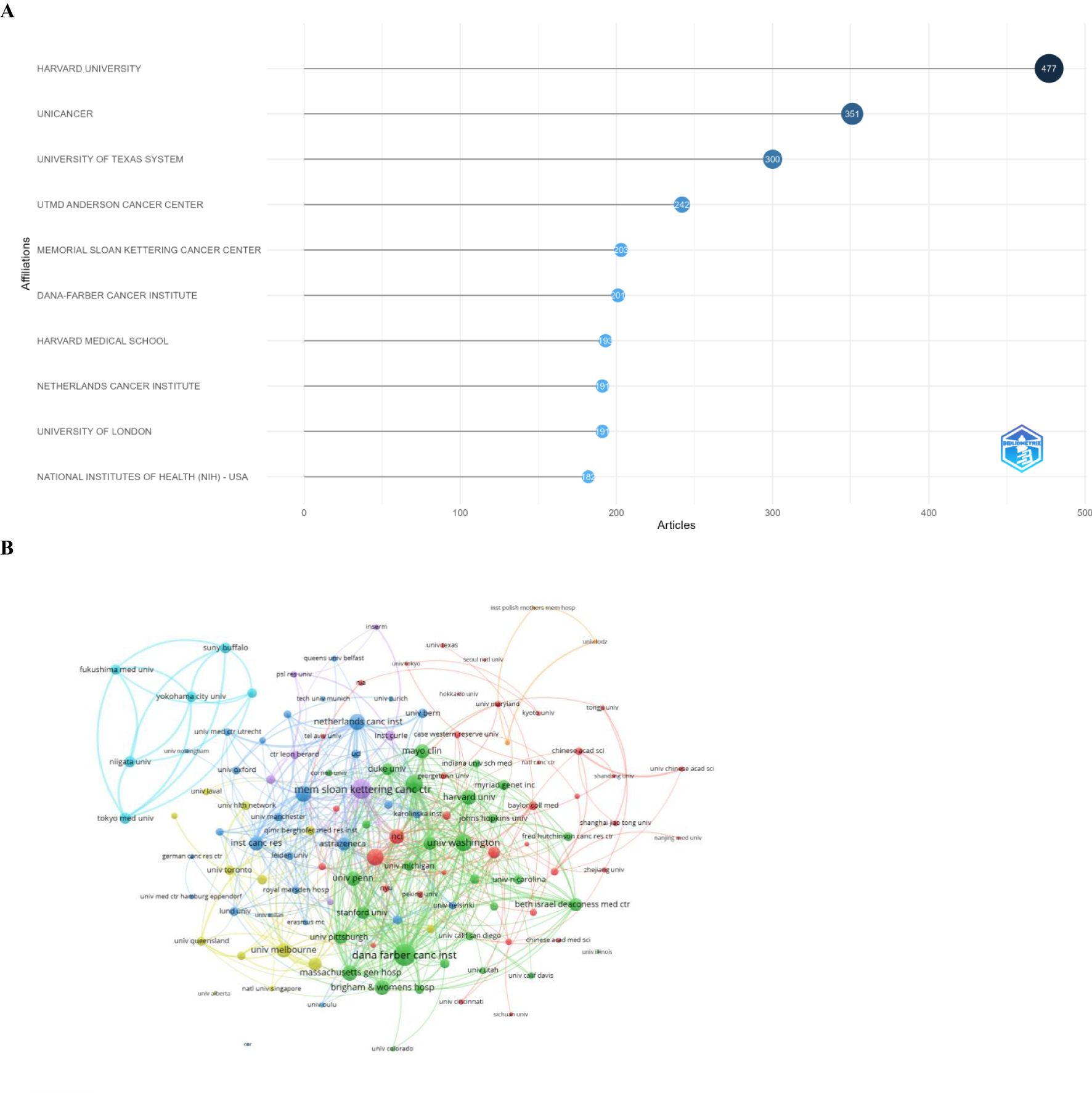
Figure 6. (A) Top 10 institutions by article number and rank (R Bibliometrix). (B) Visualization map showing collaboration among different institutions.
3.6 The analysis of keywords
A comprehensive keyword analysis of the selected articles was performed using”Author Keywords” from the Biblioshiny application and “Keywords Plus” provided by the VOSviewer application. In total, 175 keywords with a minimum of 25 occurrences were identified. Upon comparing the results from these two sources, “Keywords Plus” was found to provide more accurate results and was thus used as the primary data source for the analysis. Among the top 20 keywords with the highest total link strength and co-occurrence frequency, the top three were “homologous recombination”, “repair”, and “breast cancer” (Figure 7A; Table 7). Furthermore, among the top 20 keywords with the strongest citation bursts, the most significant burst belongs to “poly(ADP-ribose) polymerase”. Notably, since 2017, the keywords “landscape”, “maintenance therapy”, “olaparib”, “ovarian” “double-blind”, “homologous recombination deficiency”, “triple-negative breast cancer”, “neoadjuvant chemotherapy”, and “homologous recombination repair” have appeared more prominently, indicating promising developments (Figure 7B).
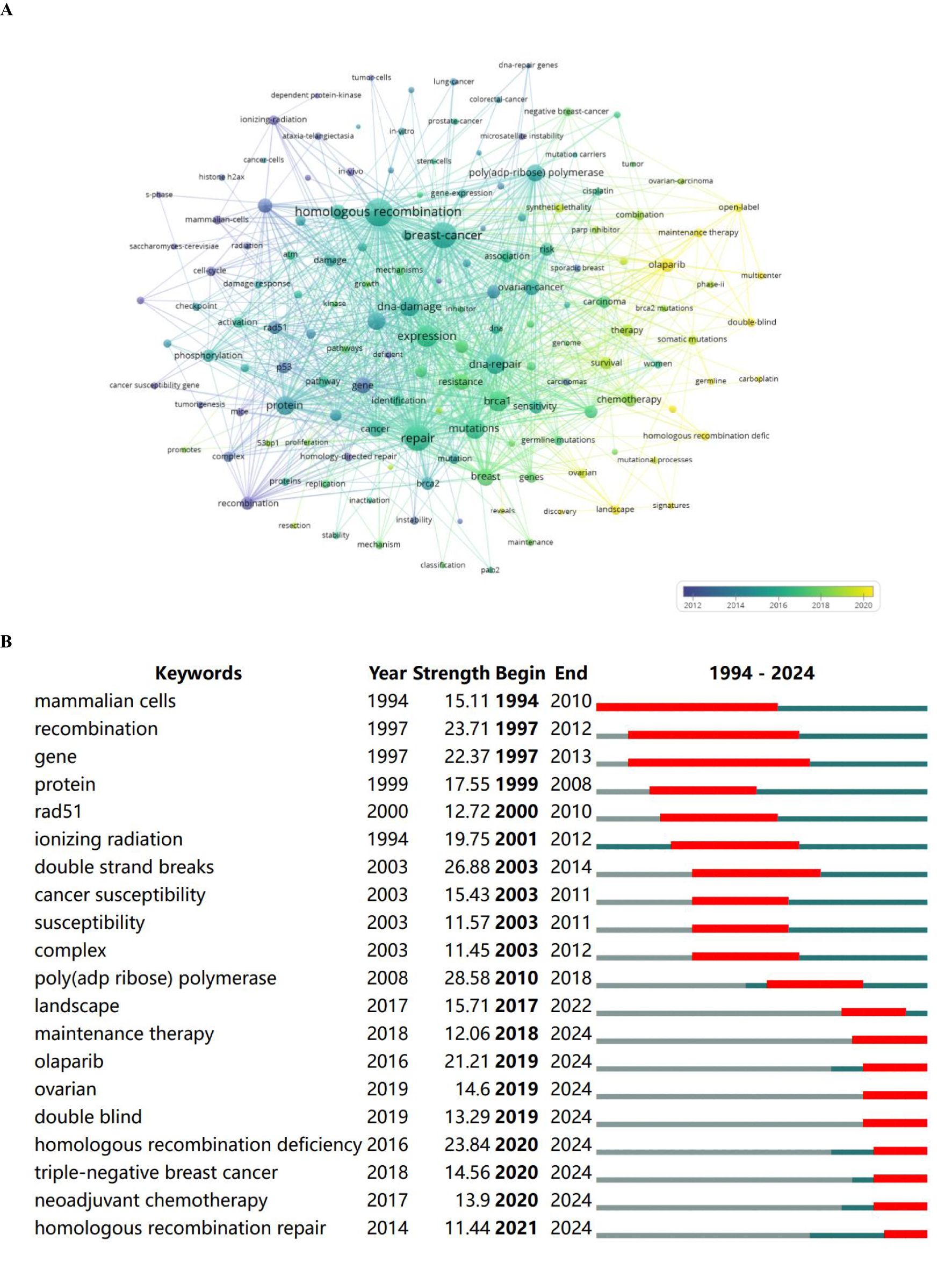
Figure 7. (A) Visual representation of the keyword co-occurrence network. (B) Top 20 keywords with the strongest citation bursts (CiteSpace).
3.7 The analysis of references
Based on the co-occurrence analysis of references cited more than 50 times, we selected the top 10 co-cited references in the field of DNA damage repair-related breast cancer. Among these, the article titled “Targeting the DNA repair defect in BRCA mutant cells as a therapeutic strategy”—published in Nature (IF = 64.8) in 2005—received 529 local citations. (doi: 10.1038/nature03445) (Figures 8A, B).
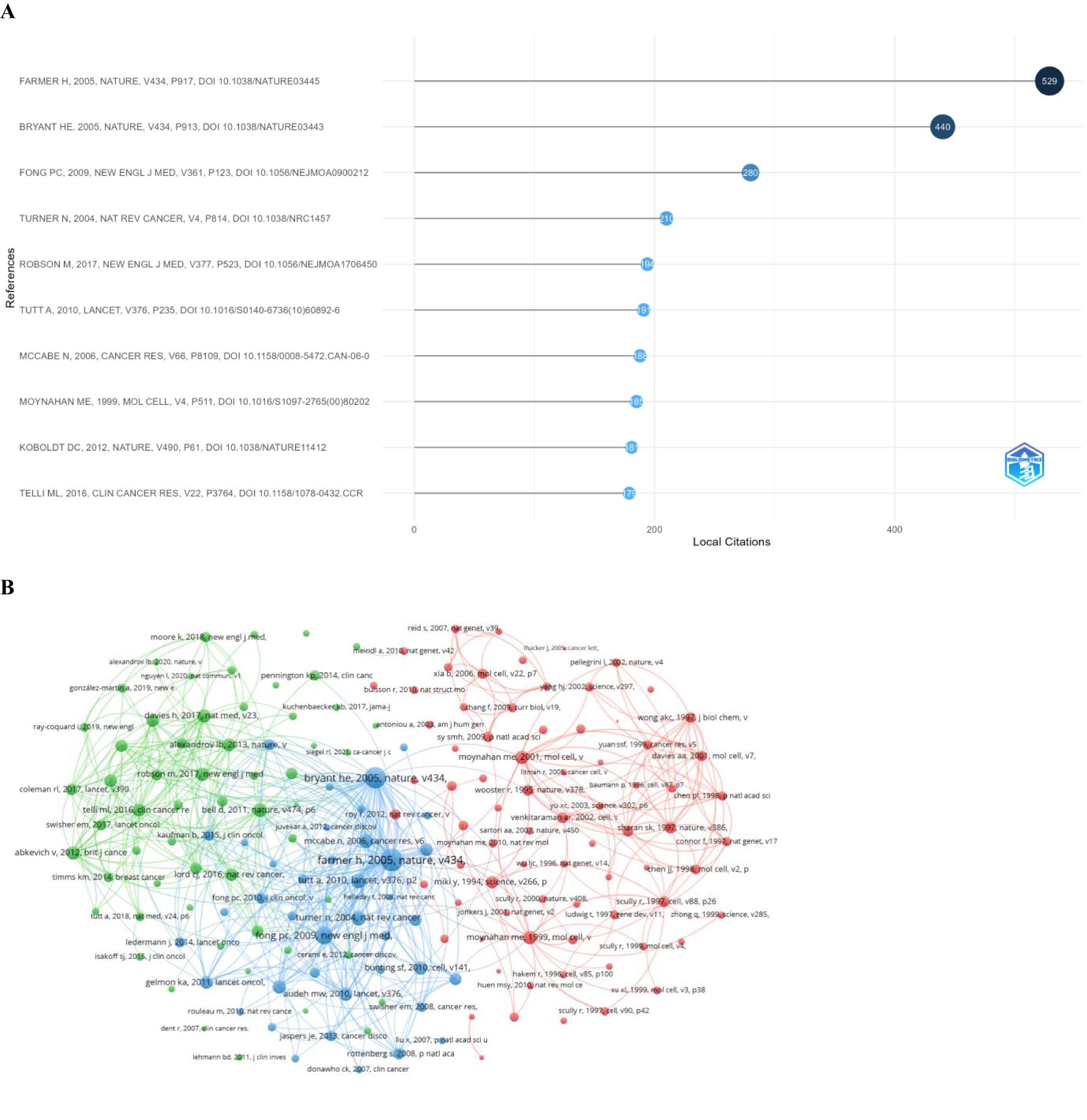
Figure 8. (A) The top 10 co-cited references in the field of DNA damage repair-related breast cancer. (B) Co-occurrence analysis of co-cited references cited more than 50 times.
3.8 Clinical trial analysis
The first clinical trial for DDR-related drugs for breast cancer was conducted in 2008 and was titled “AZD2281 Plus Carboplatin to Treat Breast and Ovarian Cancer”. Specifically, this phase I trial aimed to determine the safety and toxicity of the combination of AZD2281 (KU-0059436) and carboplatin in patients with recurrent BRCA1/2-associated or familial breast and ovarian cancer, recurrent low-genetic-risk serous ovarian cancer, and recurrent low-genetic-risk triple-negative breast cancer. The trial also aimed to assess biochemical changes in PARP and H2A histone family member X (H2AX) activity in mononuclear cells, as well as tumor response to treatment. The corpus of clinical trials for DDR-related drugs in breast cancer has expanded since that time. A notable peak occurred in 2024, with 11 trials conducted (Figure 9A). Among the 43 enumerated clinical trials, phase II trials represented the largest category, totaling 20, followed by 16 phase I trials (Figure 9B). Regarding therapy types, maintenance and palliative treatment trials were the most common, with 36 trials, followed by neoadjuvant treatment trials, which accounted for six (Figure 9C). In terms of DDR-related drug distribution across the clinical trials, a total of 13 different drugs were studied, with olaparib being the most frequently used in 16 trials, followed by ceralasertib in six trials (Figure 9D).
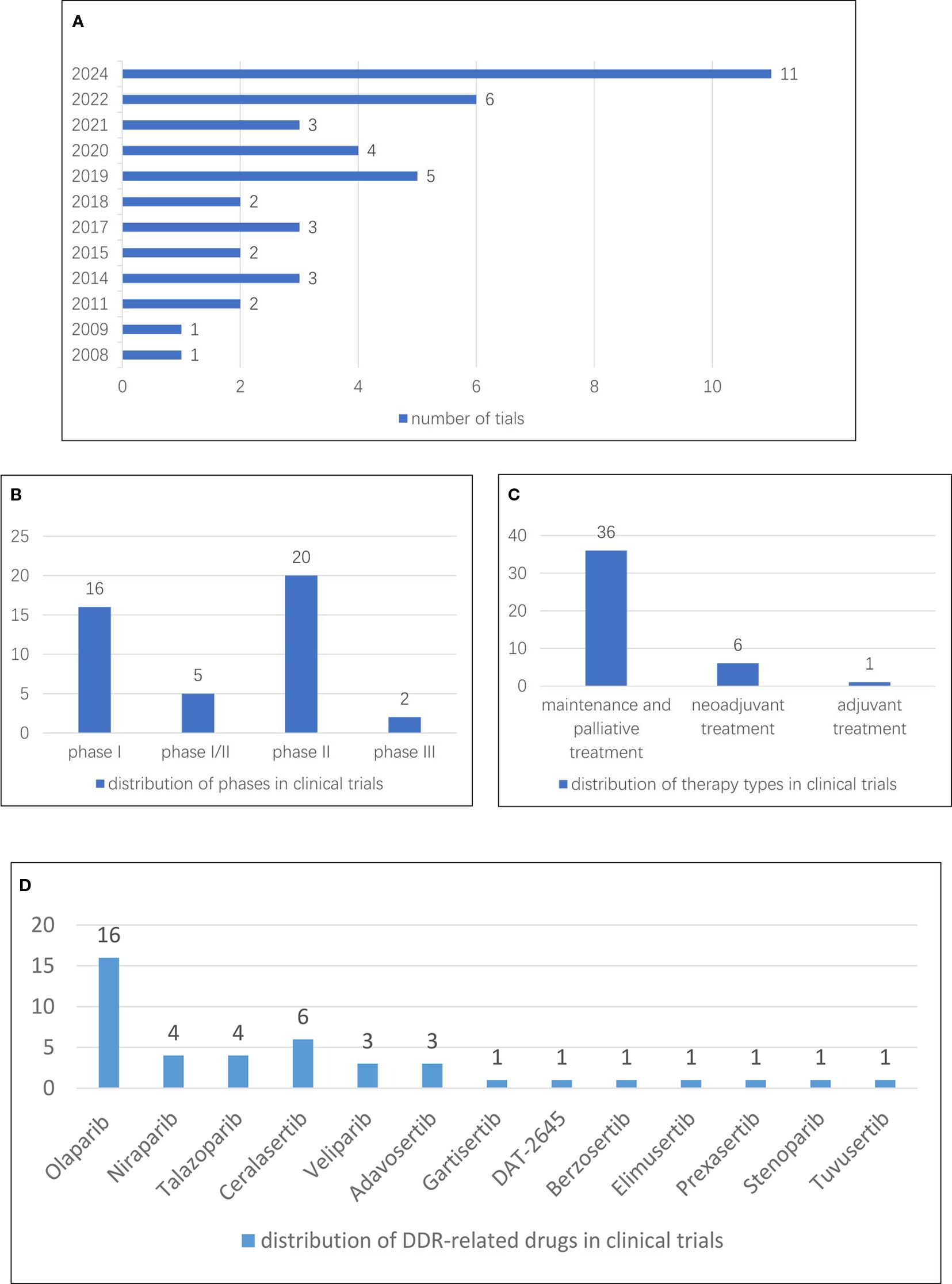
Figure 9. (A) Annual distribution of a number of clinical trials. (B) Distribution of phases in clinical trials. (C) Distribution of therapy types in clinical trials. (D) Distribution of DDR-related drugs in clinical trials.
Additionally, among these 43 clinical trials, we got the information that the National Cancer Institute (NCI) sponsored the most trials (11), followed by Sanofi with six. Regarding treatment strategies, efficacy, and outcomes, 11 trials with completed study status were identified. Among them, nine trials involved combination treatment strategies (combination of DDR-related drugs with chemotherapy or immunotherapy). Moreover, of these 11 completed trials, four were categorized as phase I, in which drug efficacy was measured by biochemical changes in tumor cells or participant response rates. The remaining six trials were phase II, and one was phase II; their outcomes were measured using pathological complete response rate (PCR) (in two neoadjuvant treatment trials), ORR, overall survival (OS), or PFS.
4 Discussion
4.1 General information related to publications
It is widely known that breast cancer is a multifaceted malignant disease influenced by genetic, environmental, and lifestyle factors. Recent studies have increasingly focused on the role of DDR mechanisms in the etiology, progression, and treatment responses of breast cancer. To shed light on the key findings and emerging themes in this area, we summarized various aspects identified through this bibliometric study. A search of publications on DDR for breast cancer from 1990 to 2024 was conducted, and the research revealed that the USA has produced the largest number of publications in this field, which might be explained by its scientific infrastructure and government funding, while Harvard University published the highest number of articles. Jonkers, Jos was found to be the most published author, with 39 documents. Analysis of the journals showed that Cancer Research ranked as the most published journal, while Nature was the most cited. Through keyword co-occurrence and co-citation analyses, it was found that the study titled “Targeting the DNA repair defect as a therapeutic strategy”, published in Nature (IF = 64.8) in 2005, received 529 local citations. This indicates that research has increasingly focused on treatment regimens. Overall, the study provides valuable insights into current research achievements, latest advancements, and emerging global trends in DNA damage repair-related breast cancer research.
For key findings, our analysis highlights major trends in DNA repair deficiency in breast cancer. A total of 175 keywords, each occurring at least 25 times, were identified (15, 31–48). The “Keywords Plus” was observed to provide more accurate results. Among the top 20 keywords with the highest total link strength and co-occurrence frequency, the three most prominent were “homologous recombination”, “repair”, and “breast cancer”. Furthermore, among the top 20 keywords with the strongest citation bursts, the most significant citation burst was observed for “poly(ADP-ribose) polymerase”. Recent studies show that since 2017, the keywords “landscape”, “maintenance therapy”, “olaparib”, “ovarian” “double-blind”, “homologous recombination deficiency”, “triple-negative breast cancer”, “neoadjuvant chemotherapy”, and “homologous recombination repair” have become more prominently featured.
4.2 Exploration and analysis of DDR mechanisms
According to the “Keywords Plus” analysis, the top three keywords with the highest total link strength and co-occurrence frequency were “homologous recombination”, “repair”, and “breast cancer”. “Homologous recombination” is the most well-known DDR pathway in breast cancer, particularly in relation to BRCA1 and BRCA2 mutations, which significantly increase the risk of the disease. Studies have shown that defects in HR can lead to unrepairable double-strand breaks, promoting tumor growth (38–42, 49). For the keywords “repair” and “breast cancer”, we reviewed the literature and synthesized information on DNA damage repair from previous studies to evaluate the role of DNA in breast cancer. DDR pathways are crucial for maintaining genomic stability, and their dysregulation can lead to tumorigenesis. For example, the BER pathway repairs small base lesions caused by oxidation or alkylation, which, if accumulated, may contribute to the initiation of breast cancer (50). NER is essential for removing bulky DNA adducts that can form in response to environmental carcinogens (51). Besides the BRCA genes, other genes involved in DDR pathways—such as PALB2, RAD51, and ATM—have also been implicated in hereditary breast and ovarian cancer syndromes. Furthermore, recent genome-wide association studies (GWAS) have identified single nucleotide polymorphisms (SNPs) associated with an increased risk of breast cancer (52), suggesting that variations in DDR capacity may contribute to breast cancer susceptibility.
Through literature screening during this bibliometric investigation, we uncovered underexplored areas within the domain of DNA damage repair mechanisms in breast cancer, which may guide future research directions in this field.
4.3 Clinical significance and clinical trials of breast cancer patients with DDR deficiency
Among the top 20 keywords with the strongest citation bursts, the most significant was observed for “poly(ADP-ribose) polymerase”, beginning in 2010. Importantly, the data indicate that since 2017, keywords such as “landscape”, “maintenance therapy”, “olaparib”, “ovarian” “double-blind”, “homologous recombination deficiency”, “triple-negative breast cancer”, “neoadjuvant chemotherapy”, and “homologous recombination repair” have gained increasing prominence. Notably, the keywords “maintenance therapy”, “olaparib”, and “neoadjuvant chemotherapy” pertain to treatment regimen regimens. Olaparib, a poly(ADP-ribose) polymerase inhibitor, has demonstrated significant efficacy in patients with hereditary breast cancer (38). Homologous recombination is a multifactorial process involving numerous proteins beyond BRCA1 and BRCA2. Genomic alterations in the genes encoding these proteins can impair HRR, making them potential targets for synthetic lethality using PARP inhibitors and other DDR-targeting agents (23). The keywords “ovarian” and “triple-negative breast cancer” prominently highlight the associated tumor types. Since 2019, the emergence of the keyword “double-blind” indicates an increasing number of clinical trials in this area. Overall, the top 20 keywords with the strongest citation bursts suggest that PARP inhibitors play a significant role in the treatment of breast cancer with DDR deficiencies, especially in triple-negative breast cancer. To develop individual treatment regimens, evidence-based medicine is essential; therefore, more high-quality clinical are urgently needed.
In the context of clinical trials, after examining databases and screening information on clinical studies involving DDR-related drugs for breast cancer, we found that 43 relevant trials have been registered since 2008. Notably, 2024 has seen a significant increase, with 11 trials registered so far. Among these, 36 trials (84% of the total) focused on advanced tumors and involved maintenance or palliative therapy. In total, 13 different DDR-related drugs have been investigated. Among these drugs, olaparib, ceralasertib, niraparib, talazoparib, veliparib, and stenoparib act as inhibitors targeting PARP, a key DDR-related protein. Additionally, ceralasertib, gartisertib, berzosertib, elimusertib, and tuvusertib act as ATR inhibitors; DAT-2645 targets PARG, adavosertib inhibits Wee1; and prexasertib functions as CHK1 inhibitor. These clinical trials have explored treatment regimens involving DDR-targeted drugs either as monotherapies or in combination with immunotherapy or chemotherapy. Identifying reliable biomarkers for DDR pathways may enhance patient stratification and optimize therapeutic outcomes.
4.4 Future investigation clues
Compared to previous studies on DNA repair deficiency in breast cancer, our analysis underscores a more focused exploration of this research field by examining publication trends, countries, authors’ impact, co-occurrence networks, article numbers from different institutions and co-occurrence networks, keywords, and references. This comprehensive approach reveals a broader and more influential research landscape. Additionally, several investigations have highlighted the role of the tumor microenvironment in modulating the response to DNA damage. The impact of environmental factors on DNA repair progress—such as ionizing radiation, chemical exposure, and the role of gut microbiota—has also been investigated to understand how these factors interact with genetic predispositions to influence breast cancer progression (53, 54). Emerging areas, such as the use of ctDNA to monitor specific DNA repair deficiencies, as well as advancements in monitoring techniques, warrant further exploration (55). Future investigations into DDR mechanisms—particularly pathways like NER and BER—in the context of ctDNA monitoring could provide valuable insights. Moreover, immunotherapy strategies may become increasingly relevant when considering the impact of environmental factors on DNA repair processes. Integrating genomic, transcriptomic, proteomic, and metabolomic data could offer a more comprehensive understanding of DDR mechanisms in breast cancer, potentially unveiling novel therapeutic targets and informing the development of personalized treatment approaches.
4.5 Limitations
Nevertheless, while bibliometric studies offer valuable insights, they also present limitations, such as bias toward publication frequency and the uneven impact of different research areas. To enhance the robustness of future analyses, it is essential to complement bibliometric data with qualitative assessments, including focus groups and expert interviews. Furthermore, as investigations continue to evolve, continuous efforts are needed to update bibliometric databases and analyses to capture emerging trends and breakthroughs in DDR-related breast cancer research. By synthesizing quantitative data with qualitative insights, stakeholders can adopt a more informed and strategic approach to advancing breast cancer studies, ultimately improving patient outcomes.
5 Conclusion
Research on DNA damage repair mechanisms in breast cancer has expanded significantly, providing deep insights into the etiology, progression, and treatment response of the disease. The interplay between genetic and environmental factors within DDR pathways highlights the complex nature of breast cancer. Increasingly, investigations—particularly those focusing on genetic predispositions, treatment strategies, and targeted therapies—hold great promise for improving patient outcomes and advancing personalized care. As we continue to advance our understanding of these mechanisms through this bibliometric study, our goal remains to translate scientific discoveries into tangible clinical benefits for patients.
Data availability statement
The raw data supporting the conclusions of this article will be made available by the authors, without undue reservation.
Author contributions
YH: Conceptualization, Formal Analysis, Methodology, Writing – original draft, Writing – review & editing. SW: Writing – review & editing. KH: Methodology, Writing – review & editing. XX: Writing – review & editing.
Funding
The author(s) declare that no financial support was received for the research and/or publication of this article.
Conflict of interest
The authors declare that the research was conducted in the absence of any commercial or financial relationships that could be construed as a potential conflict of interest.
The reviewer HL declared a shared parent affiliation with the authors to the handling editor at the time of review.
Correction note
A correction has been made to this article. Details can be found at: 10.3389/fonc.2025.1646064.
Generative AI statement
The author(s) declare that no Generative AI was used in the creation of this manuscript.
Publisher’s note
All claims expressed in this article are solely those of the authors and do not necessarily represent those of their affiliated organizations, or those of the publisher, the editors and the reviewers. Any product that may be evaluated in this article, or claim that may be made by its manufacturer, is not guaranteed or endorsed by the publisher.
References
1. Meindl A, Hellebrand H, Wiek C, Erven V, Wappenschmidt B, Niederacher D, et al. Germline mutations in breast and ovarian cancer pedigrees establish RAD51C as a human cancer susceptibility gene. Nat Genet. (2010) 42:410–4. doi: 10.1038/ng.569
2. Patel PS, Algouneh A, and Hakem R. Exploiting synthetic lethality to target BRCA1/2-deficient tumors: where we stand. Oncogene. (2021) 40:3001–14. doi: 10.1038/s41388-021-01744-2
3. Li X, Li C, Zhang L, Wu M, Cao K, Jiang F, et al. The significance of exosomes in the development and treatment of hepatocellular carcinoma. Mol Cancer. (2020) 19:1. doi: 10.1186/s12943-019-1085-0
4. Thorat MA and Balasubramanian R. Breast cancer prevention in high-risk women. Best Pract Res Clin Obstet Gynaecol. (2020) 65:18–31. doi: 10.1016/j.bpobgyn.2019.11.006
5. Britt KL, Cuzick J, and Phillips KA. Key steps for effective breast cancer prevention. Nat Rev Cancer. (2020) 20:417–36. doi: 10.1038/s41568-020-0266-x
6. Pantelidou C, Sonzogni O, De Oliveria Taveira M, Mehta A K, Kothari A, Wang D, et al. PARP inhibitor efficacy depends on CD8+ T-cell recruitment via intratumoral STING pathway activation in BRCA-deficient models of triple-negative breast cancer. Cancer Discov. (2019) 9:722–37. doi: 10.1158/2159-8290.CD-18-1218
7. Curtin NJ. DNA repair dysregulation from cancer driver to therapeutic target. Nat Rev Cancer. (2012) 12:801–17. doi: 10.1038/nrc3399
8. O’Connor MJ. Targeting the DNA damage response in cancer. Mol Cell. (2015) 60:547–60. doi: 10.1016/j.molcel.2015.10.040
9. Wu J, Wei Y, Pan J, Jin S, Gu W, Gan H, et al. Prevalence of comprehensive DNA damage repair gene germline mutations in Chinese prostate cancer patients. Int J Cancer. (2021) 148:673–81. doi: 10.1002/ijc.v148.3
10. Dall’Era MA, McPherson JD, Gao AC, DeVere White RW, Gregg JP, and Lara PN Jr. Germline and somatic DNA repair gene alterations in prostate cancer. Cancer. (2020) 126:2980–5. doi: 10.1002/cncr.32908
11. Goldstein JB, Zhao L, Wang X, Ghelman Y, Overman MJ, Javle MM, et al. Germline DNA sequencing reveals novel mutations predictive of overall survival in a cohort of patients with pancreatic cancer. Clin Cancer Res. (2020) 26:1385–94. doi: 10.1158/1078-0432.CCR-19-0224
12. Valencia OM, Samuel SE, Viscusi RK, Riall TS, Neumayer LA, and Aziz H. The role of genetic testing in patients with breast cancer: a review. JAMA Surg. (2017) 152:589–94. doi: 10.1001/jamasurg.2017.0552
13. Tung N, Lin NU, Kidd J, Allen BA, Singh N, Wenstrup RJ, et al. Frequency of germline mutations in 25 cancer susceptibility genes in a sequential series of patients with breast cancer. J Clin Oncol. (2016) 34:1460–8. doi: 10.1200/JCO.2015.65.0747
14. Ali RM, McIntosh SA, and Savage KI. Homologous recombination deffciency in breast cancer: Implications for risk, cancer development, and therapy. Gene Chromosome Cancer. (2021) 60:358–72. doi: 10.1002/gcc.22921
15. Jaspers JE, Kersbergen A, Boon U, Sol W, van Deemter L, Zander SA, et al. Loss of 53BP1 causes PARP inhibitor resistance in Brca1-mutated mouse mammary tumors. Cancer Discov. (2013) 3:68–81. doi: 10.1158/2159-8290.CD-12-0049
16. Song M, Cui M, and Liu K. Therapeutic strategies to overcome cisplatin resistance in ovarian cancer. Eur J Med Chem. (2022) 232:114205. doi: 10.1016/j.ejmech.2022.114205
17. Zhu H, Luo H, Zhang W, Shen Z, Hu X, and Zhu X. Molecular mechanisms of cisplatin resistance in cervical cancer. Drug Des Dev Ther. (2016) 10:1885. doi: 10.2147/DDDT.S106412
18. Gong Z, Yang Y, Zhang J, and Guo W. Evaluation of 30 DNA damage response and 6 mismatch repair gene mutations as biomarkers for immunotherapy outcomes across multiple solid tumor types. Cancer Biol Med. (2021) 18:1080. doi: 10.20892/j.issn.2095-3941.2020.0351
19. Kwon M, Kim G, Kim R, Kim KT, Kim ST, Smith S, et al. Phase II study of ceralasertib (AZD6738) in combination with durvalumab in patients with advanced gastric cancer. J Immunother Cancer. (2022) 10:e005041. doi: 10.1136/jitc-2022-005041
20. Balar AV, Galsky MD, Rosenberg JE, Powles T, Petrylak DP, Bellmunt J, et al. Atezolizumab as ffrst-line treatment in cisplatin-ineligible patients with locally advanced and metastatic urothelial carcinoma: a single-arm, multicentre, phase 2 trial. Lancet. (2017) 389:67–76. doi: 10.1016/S0140-6736(16)32455-2
21. Teo MY, Seier K, Ostrovnaya I, Regazzi AM, Kania BE, Moran MM, et al. Alterations in DNA damage response and repair genes as potential marker of clinical benefft from PD-1/PD-L1 blockade in advanced urothelial cancers. J Clin Oncol. (2018) 36:1685–94. doi: 10.1200/JCO.2017.75.7740
22. Vonderheide RH, Domchek SM, and Clark AS. Immunotherapy for breast cancer: what are we missing? Clin Cancer Res. (2017) 23:2640–6. doi: 10.1158/1078-0432.CCR-16-2569
23. Morganti S, Marra A, De Angelis C, Toss A, Licata L, Giugliano F, et al. PARP inhibitors for breast cancer treatment: A review. JAMA Oncol. (2024) 10:658–70. doi: 10.1001/jamaoncol.2023.7322
24. Robson M, Im SA, Senkus E, Xu B, Domchek SM, Masuda N, et al. Olaparib for metastatic breast cancer in patients with a germline BRCA mutation. N Engl J Med. (2017) 377:523–33. doi: 10.1056/NEJMoa1706450
25. Wilson M, Sampson M, Barrowman N, and Doja A. Bibliometric Analysis of Neurology Articles Published in General Medicine Journals. JAMA Netw Open. (2021) 10:e215840. doi: 10.1001/jamanetworkopen.2021.5840
26. Sohail SS, Javed Z, Nadeem M, Anwer F, Farhat F, Hussain A, et al. Multi-criteria decision making-based waste management: A bibliometric analysis. Heliyon. (2023) 9:e21261. doi: 10.1016/j.heliyon.2023.e21261
27. Hou Y and Yu Z. A bibliometric analysis of synchronous computer-mediated communication in language learning using VOSviewer and citNetExplorer. Educ Sci. (2023) 13:125. doi: 10.3390/educsci13020125
28. Wang Y, Wang Z, Wang Z, Li X, Pang X, and Wang S. Application of discrete choice experiment in health care: A bibliometric analysis. Front Public Health. (2021) 9:673698. doi: 10.3389/fpubh.2021.673698
29. van Eck NJ and Waltman L. Software survey: VOSviewer, a computer program for bibliometric mapping. Scientometrics. (2010) 84:523–38. doi: 10.1007/s11192-009-0146-3
30. Yao L, Hui L, Yang Z, Chen X, and Xiao A. Freshwater microplastics pollution: Detecting and visualizing emerging trends based on Citespace II. Chemosphere. (2020) 245:125627. doi: 10.1016/j.chemosphere.2019.125627
31. Farmer H, McCabe N, Lord CJ, Tutt AN, Johnson DA, Richardson TB, et al. Targeting the DNA repair defect in BRCA mutant cells as a therapeutic strategy. Nature. (2005) 434:917–21. doi: 10.1038/nature03445
32. Mirza MR, Monk BJ, Herrstedt J, Oza AM, Mahner S, Redondo A, et al. Niraparib maintenance therapy in platinum-sensitive, recurrent ovarian cancer. N Engl J Med. (2016) 375:2154–64. doi: 10.1056/NEJMoa1611310
33. Nik-Zainal S, Davies H, Staaf J, Ramakrishna M, Glodzik D, Zou X, et al. Landscape of somatic mutations in 560 breast cancer whole-genome sequences [published correction appears in Nature. Nature. (2016) 534:47–54. doi: 10.1038/nature17676
34. Tutt A, Robson M, Garber JE, Domchek SM, Audeh MW, Weitzel JN, et al. Oral poly(ADP-ribose) polymerase inhibitor olaparib in patients with BRCA1 or BRCA2 mutations and advanced breast cancer: a proof-of-concept trial. Lancet. (2010) 376:235–44. doi: 10.1016/S0140-6736(10)60892-6
35. McCabe N, Turner NC, Lord CJ, Kluzek K, Bialkowska A, Swift S, et al. Deficiency in the repair of DNA damage by homologous recombination and sensitivity to poly(ADP-ribose) polymerase inhibition. Cancer Res. (2006) 66:8109–15. doi: 10.1158/0008-5472.CAN-06-0140
36. Schlacher K, Christ N, Siaud N, Egashira A, Wu H, and Jasin M. Double-strand break repair-independent role for BRCA2 in blocking stalled replication fork degradation by MRE11 [published correction appears in Cell. Cell. (2011) 145:529–42. doi: 10.1016/j.cell.2011.03.041
37. Pennington KP, Walsh T, Harrell MI, Lee MK, Pennil CC, Rendi MH, et al. Germline and somatic mutations in homologous recombination genes predict platinum response and survival in ovarian, fallopian tube, and peritoneal carcinomas. Clin Cancer Res. (2014) 20:764–75. doi: 10.1158/1078-0432.CCR-13-2287
38. Tutt ANJ, Garber JE, Kaufman B, Viale G, Fumagalli D, Rastogi P, et al. Adjuvant olaparib for patients with BRCA1- or BRCA2-mutated breast cancer. N Engl J Med. (2021) 384:2394–405. doi: 10.1056/NEJMoa2105215
39. Telli ML, Timms KM, Reid J, Hennessy B, Mills GB, Jensen KC, et al. Homologous recombination deficiency (HRD) score predicts response to platinum-containing neoadjuvant chemotherapy in patients with triple-negative breast cancer. Clin Cancer Res. (2016) 22:3764–73. doi: 10.1158/1078-0432.CCR-15-2477
40. Tutt A, Tovey H, Cheang MCU, Kernaghan S, Kilburn L, Gazinska P, et al. Carboplatin in BRCA1/2-mutated and triple-negative breast cancer BRCAness subgroups: the TNT Trial. Nat Med. (2018) 24:628–37. doi: 10.1038/s41591-018-0009-7
41. Denkert C, Liedtke C, Tutt A, and von Minckwitz G. Molecular alterations in triple-negative breast cancer-the road to new treatment strategies. Lancet. (2017) 389:2430–42. doi: 10.1016/S0140-6736(16)32454-0
42. Prakash R, Zhang Y, Feng W, and Jasin M. Homologous recombination and human health: the roles of BRCA1, BRCA2, and associated proteins. Cold Spring Harb Perspect Biol. (2015) 7:a016600. doi: 10.1101/cshperspect.a016600
43. Sandhu SK, Schelman WR, Wilding G, Moreno V, Baird RD, Miranda S, et al. The poly(ADP-ribose) polymerase inhibitor niraparib (MK4827) in BRCA mutation carriers and patients with sporadic cancer: a phase 1 dose-escalation trial. Lancet Oncol. (2013) 14:882–92. doi: 10.1016/S1470-2045(13)70240-7
44. Xu G, Chapman JR, Brandsma I, Yuan J, Mistrik M, Bouwman P, et al. REV7 counteracts DNA double-strand break resection and affects PARP inhibition. Nature. (2015) 521:541–4. doi: 10.1038/nature14328
45. Germano G, Lamba S, Rospo G, Barault L, Magrì A, Maione F, et al. Inactivation of DNA repair triggers neoantigen generation and impairs tumour growth. Nature. (2017) 552:116–20. doi: 10.1038/nature24673
46. Bertucci F, Ng CKY, Patsouris A, Droin N, Piscuoglio S, Carbuccia N, et al. Genomic characterization of metastatic breast cancers [published correction appears in Nature. Nature. (2019) 569:560–4. doi: 10.1038/s41586-019-1056-z
47. Noordermeer SM, Adam S, Setiaputra D, Barazas M, Pettitt SJ, Ling AK, et al. The shieldin complex mediates 53BP1-dependent DNA repair. Nature. (2018) 560:117–21. doi: 10.1038/s41586-018-0340-7
48. Swisher EM, Lin KK, Oza AM, Scott CL, Giordano H, Sun J, et al. Rucaparib in relapsed, platinum-sensitive high-grade ovarian carcinoma (ARIEL2 Part 1): an international, multicentre, open-label, phase 2 trial. Lancet Oncol. (2017) 18:75–87. doi: 10.1016/S1470-2045(16)30559-9
49. Groelly FJ, Fawkes M, Dagg RA, Blackford AN, and Tarsounas M. Targeting DNA damage response pathways in cancer. Nat Rev Cancer. (2023) 23:78–94. doi: 10.1038/s41568-022-00535-5
50. Wright G and Gassman NR. Transcriptional dysregulation of base excision repair proteins in breast cancer. DNA Repair (Amst). (2020) 93:102922. doi: 10.1016/j.dnarep.2020.102922
51. Pietrasik S, Zajac G, Morawiec J, Soszynski M, Fila M, and Blasiak J. Interplay between BRCA1 and GADD45A and its potential for nucleotide excision repair in breast cancer pathogenesis. Int J Mol Sci. (2020) 21:870. doi: 10.3390/ijms21030870
52. Jia G, Ping J, Guo X, Yang Y, Tao R, Li B, et al. Genome-wide association analyses of breast cancer in women of African ancestry identify new susceptibility loci and improve risk prediction. Nat Genet. (2024) 56:819–26. doi: 10.1038/s41588-024-01736-4
53. Srinivas US, Tan BWQ, Vellayappan BA, and Jeyasekharan AD. ROS and the DNA damage response in cancer. Redox Biol. (2019) 25:101084. doi: 10.1016/j.redox.2018.101084
54. Wu Z, Zhang S, Li L, Huang Z, Huang D, and Hu Y. The gut microbiota modulates responses to anti-PD-1 and chemotherapy combination therapy and related adverse events in patients with advanced solid tumors. Front Oncol. (2022) 12:887383. doi: 10.3389/fonc.2022.887383
Keywords: DNA damage repair, breast cancer, global trends, bibliometric study, CiteSpace, VOSviewer
Citation: Huang Y, Wei S, Hu K and Xiang X (2025) Knowledge mapping of global trends in DNA damage repair-related breast cancer research: a bibliometric study. Front. Oncol. 15:1562539. doi: 10.3389/fonc.2025.1562539
Received: 12 March 2025; Accepted: 30 April 2025;
Published: 29 May 2025; Corrected: 09 September 2025.
Edited by:
Gianluca Tedaldi, AUSL Romagna, ItalyReviewed by:
Prem Prakash, Meharry Medical College, United StatesSungchan Gwark, Ewha Womans University Seoul Hospital, Republic of Korea
Hui Lu, Zhejiang University, China
Copyright © 2025 Huang, Wei, Hu and Xiang. This is an open-access article distributed under the terms of the Creative Commons Attribution License (CC BY). The use, distribution or reproduction in other forums is permitted, provided the original author(s) and the copyright owner(s) are credited and that the original publication in this journal is cited, in accordance with accepted academic practice. No use, distribution or reproduction is permitted which does not comply with these terms.
*Correspondence: Yajing Huang, aHlqMDA4N0B6anUuZWR1LmNu
 Yajing Huang
Yajing Huang Shumei Wei1
Shumei Wei1 Kaimin Hu
Kaimin Hu Xueping Xiang
Xueping Xiang
